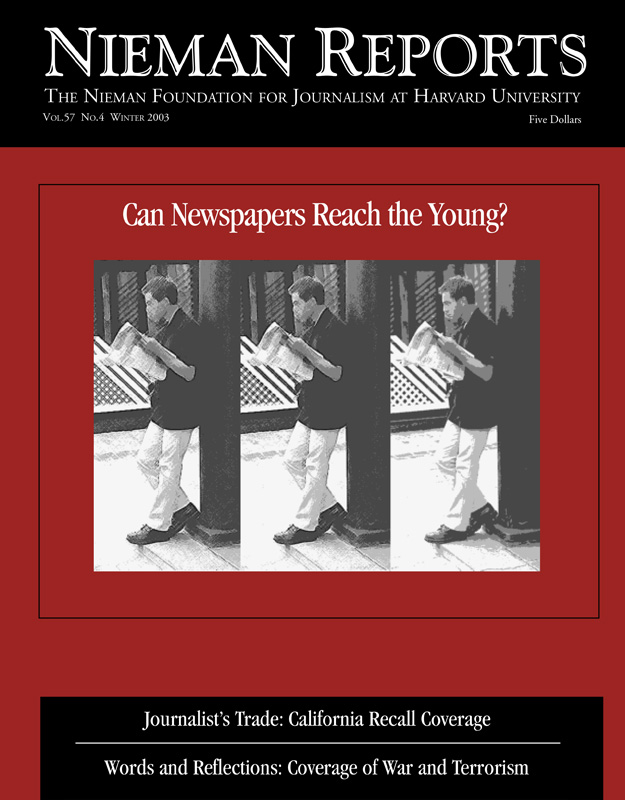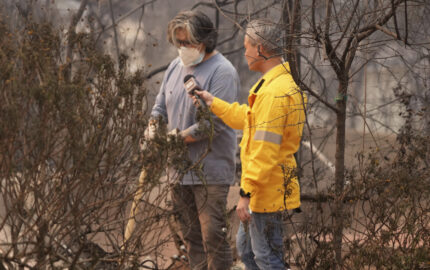In October, the Committee to Protect Journalists (CPJ) released an updated version of its guide to reporting on war and in other situations in which journalists’ lives can be threatened. The handbook is called “On Assignment: A Guide to Reporting in Dangerous Situations,” and what follows are excerpts taken from its various sections.
Part I: Introduction
“In the early months of 2002, Wall Street Journal reporter Daniel Pearl was abducted and executed by his captors while pursuing a story about Islamic militants in Pakistan. The kid-napping—which came only weeks after eight reporters were killed covering the conflict in Afghanistan and a little more than one year before 11 journalists died covering the war in Iraq be-
tween March 19 and April 9, when Baghdad fell—was a terrible reminder for journalists around the world of their vulnerability.
“In the aftermath of Pearl’s murder, veteran journalists—including the most seasoned war correspondents—began examining their own routines: Could they suffer Pearl’s fate? What can they and their media organizations do to make their work safer? How should they respond in an emergency? Are there new security issues for those reporting on terrorism, as Daniel Pearl was, in the wake of the September 11, 2001 attacks …?”
From Part II: Who is at Risk?
“Recent fatalities in Iraq illustrate the dangers faced by war correspondents. But the hazards of war coverage are not limited to combat. During and after the three weeks of fighting in Iraq, several journalists died from either medical conditions that proved fatal in the field or from road accidents. … But even all the risks of reporting in a conflict zone comprise only a small part of the risks journalists face worldwide. In fact, for every journalist killed in crossfire, three are targeted for murder. Between 1993 and 2002, CPJ research indicates that 366 journalists have been killed while conducting their work; of that total, 60 journalists, or 16 percent, died in crossfire, while 277 journalists, or 76 percent, were murdered in reprisal for their reporting. The remaining journalists were killed on the job in other situations, such as violent street demonstrations.”
From Part IV: Reporting in Hostile Areas: Minimizing Risks
“Journalists covering conflicts should never carry arms or travel with other journalists who carry weapons. Doing so jeopardizes a journalist’s status as a neutral observer and can make combatants view correspondents as legitimate military targets. … In some particularly dangerous conflicts, journalists have hired armed guards. The practice first became widespread among television crews and reporters covering Somalia in the early 1990’s after journalists traveling without armed guards were robbed at gunpoint. Journalists who use armed guards, however, should recognize that they may be jeopardizing their status as neutral observers. For example, CNN crews used armed guards in northern Iraq in 2003. On one occasion, unidentified attackers shot CNN’s vehicle, which was clearly marked with ‘Press,’ and CNN’s hired guard returned fire. The gunmen continued to shoot the vehicle as it turned around and drove away. CNN International president, Chris Cramer, defended the network’s use of armed guards as necessary to protect CNN personnel in Iraq. Robert Menard, secretary-general of the Paris-based press freedom watchdog group Reporters san Frontieres, however, criticized CNN, saying that the practice ‘risks endangering all other reporters.’”
From Part IV: Reporting in Hostile Areas: Battlefield Choices
“Although the term ‘embedding,’ or placing journalists with troops in wartime, was recently coined by U.S. Defense Department officials in 2002, the practice is as old as the earliest war correspondents. … From at least the U.S. Civil War through the first two world wars, journalists who accompanied combatants were only able to file reports through military censors. …
“Journalists briefly enjoyed more autonomy during the Korean War, although it was not until the Vietnam War that many correspondents were able to file without censorship. This practice changed remarkably with subsequent conflicts. U.S. officials, along with their local allies, tried to keep journalists away from the fighting in El Salvador, Grenada, Panama, the 1991 Gulf War, and Afghanistan. …
“U.S. officials changed policy, however, during the 2003 war in Iraq. By the time the three-week conflict was over, more than 800 journalists of various nationalities, including correspondents reporting in English and Arabic, had been embedded with either U.S. or U.K. forces. … Whether to embed with any armed forces is a decision involving trade-offs. A primary advantage of embedding is that a journalist will get a firsthand, frontline view of armed forces in action. But there are also disadvantages. An embedded journalist is only able to cover that single part of the story, and his or her reporting can become one-sided as a result of becoming too close to the soldiers. …”
“Since as early as the Vietnam War, U.S. Defense Department officials have used the term ‘unilaterals’ to describe journalists covering conflicts independently. Such reporting provides invaluable and compelling dispatches, but sometimes at the price of high personal risk. … In one particularly chilling series of episodes, on the morning of April 8, 2003, U.S.-led forces fired on the offices of two international news broadcasters and a hotel filled with journalists in three separate attacks in Baghdad. One journalist died in the missile strike on the Al Jazeera network studio, equipment was damaged at the Abu Dhabi TV studio, and two cameramen died when a tank fired on the Palestine Hotel, which was being used as a base of operations by about 100 journalists at the time. …
“According to CPJ, U.S. Defense Department officials, as well as commanders on the ground in Baghdad, knew that the Palestine Hotel was full of international journalists and were intent on not hitting it. However, these senior officers apparently failed to convey their concern to the tank commander who fired on the hotel.”




